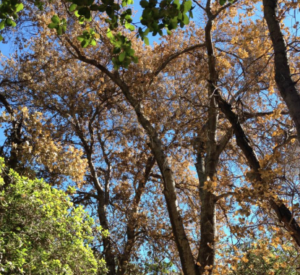News & Advice From The Leading Thousand Oaks Tree Trimming Company
The beautiful oak trees that Thousand Oaks is named after are under attack. The pest causing problems is the Western oak bark beetle (WOBB). It’s a small beetle that burrows through the oak’s bark, digging shallow tunnels under the surface. After digging their tunnels, female beetles lay eggs in the tunnels, and the developing larvae then dig their own tunnels at right angles close to the surface.

Brown oak trees need to be inspected
The beetle loves a warm, Mediterranean climate that is found in the southern coastal regions of California where the climate is mild and constant year-round — exactly what the Conejo Valley is famous for.
The problem arises not so much from the burrowing beetle but from the after-effects — namely, a fungus called foamy bark canker disease that develops in the tunnels. The fungus blocks water and nutrients from circulating inside the oaks, which then causes the oak to turn brown. WOBB generally attack trees weakened by drought, disease or other injuries. The disease is raising wildfire danger concerns as dead trees provide wildfire fuel.
Common Symptoms
- Wet discoloration on the oak’s bark
- Entry holes from the burrowing beetle
- Reddish sap oozing from entry holes
- Foamy liquid from entry holes
You can identify a WOBB infestation by the red sap and cream-colored foam that comes out of holes in the oak’s trunks and branches. These are early signs of an infestation and are visible as the sap leaks from the insect entry holes. The sap is reddish in color and may ooze from the entry hole, followed by a foamy liquid that can leak as far as two feet down the trunk.
After the fungus has done some damage, the sap and foam stop flowing, and the only remaining evidence of the beetle and the fungus is the small holes.
Treatment
If only the oak’s branches are infected, we can prune the tree to stop the spread of the disease. Unfortunately, there aren’t any control methods in place to stop the fungus or the beetle. Even worse, if the infection is at an advanced stage, the oak tree dies.
If you notice an oak on your property has these symptoms, give us a call. It’s important to diagnose the beetle and the disease correctly and promptly. That’s the best way to manage the disease. If it’s in its early stages, we have options. But if a tree has been infected for some time, removing the tree is the most effective way to prevent the disease from spreading. Conventional methods of tree thinning and the use of insecticides have been used to fight the beetle. But these methods only work if they’re utilized before the beetles have begun colonizing and before the fungus has taken hold within the tree.
One Other Note
During the summer, people often think about bringing their own firewood when they go camping. Don’t! The beetle can be spread you move infested firewood to other areas. For a nice camp fire, purchase firewood from a local source.

